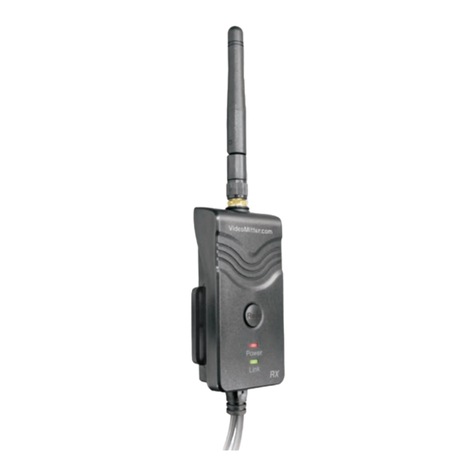These transmitters work over the 2.4Ghz band
and are paired to a receiver to provide
security and signal quality. The pairing selects
a random ID code from an extensive ID range
and is shared only by the transmitter and
receiver pair. Therefore the wireless video
signal cannot be received by any receiver
other than its own. It should therefore only
be necessary to rerun the pairing procedure
if either the transmitter or receiver has to be
replaced.
Unlike analogue transmitters, the VideoMitter
has no dipswitches for selecting transmission
bands in the 2.4GHz range. It uses an
automatic channel hopping feature to select
a clear usable channel and this channel may
change frequently dependent on the trafc
detected on the channel band. Therefore
spurious use by other equipment e.g WiFi,
will trigger the unit to search for another
available channel seamlessly. The channel
hopping facility also allows a number of
paired VideoMitters to be installed at the same
location. The total number of channels that can
operate at one site is a maximum of 20. Note
that this number is dependent on other trafc
density so the number may be less.
Always ensure that the transmitter and receiver
have line of sight. Any obstacles will have
an effect on the video signal. Line of sight
means that there are no materials between
the transmitter and receiver, only air. Placing
units behind glass is not line of sight. Metal
can completely block a transmission, whereas
non-metallic obstacles will introduce a certain
amount of signal attenuation. Providing
this attenuation does not corrupt the digital
transmission, the results should always be very
good. Note that dense material close to the
transmitter will have the greatest effect.
Increasing signal gain can be accomplished
by tting an improved antenna. These are
described in more detail, later in this instruction
manual. Without line of sight, no guarantee
can be given on transmission distance.
Q.1 I cannot pair the Transmitter
and Receiver. I keep getting a
“No Video Signal” displayed.
A.1 If no video signal is displayed but the
Link LEDs are permanently lit on both the
Transmitter and Receiver, the units are paired.
The No Video Signal is displayed if the units
are setup without a video input. Ensure a video
or camera signal is connected to the TX input.
Q.2 The monitor displays a static picture.
A.2 The video stream is no longer being
transmitted. Check that the power led on the
Transmitter is permanently lit. If not check the
power supply is delivering 12v DC.
Q.3 I am getting No Video Signal or the
video stream is very slow.
A.3 If the distance is within range but you
do not have line of sight, then the problem
may be due to obstacles screening the video
signal. Metal is the main substance that can
completely screen a wireless signal, therefore
avoid completely metal constructions. Metal
gates, plasterboard lined with aluminium
sheeting, metal cages or vehicle cabs or lorries
etc can also screen the video signal. As the
VideoMitter pack will either provide good
video quality or nothing at all, you can either
move the equipment to provide line of sight,
use an external antenna and extension lead
that will allow line of sight or you can try a
morepowerfulantenna.Youwillndthatthick
brick or stone wall constructions will reduce
signal strength and the closer they are to the
transmitter the greater their effect.
Q.4 When the Transmitter or Receiver is
rst connected to power, the Link LED lights
then extinguishes and then after 4 seconds
after both units have been powered, they
both show a permanent Link LED light on.
Troubleshooting
VideoMitter Lite Instructions
™
Email: support@videomitter.com Web: www.VideoMitter.com10




























